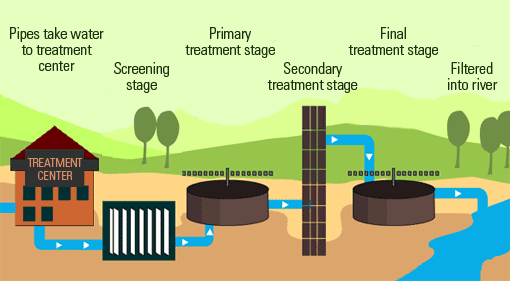Economical Solutions for Large-Scale Waste Water Treatment Facilities
Economical Solutions for Large-Scale Waste Water Treatment Facilities
Blog Article
Strategic Approaches to Improve Drainage Therapy Performance and Reduce Ecological Effect
In the world of waste water treatment, the pursuit for improved efficiency and lowered ecological impact is a perpetual challenge that requires calculated remedies. As culture faces the important to take care of water resources sustainably, a nuanced approach comes to be important. The integration of advanced treatment technologies, energy-efficient processes, source healing approaches, improved nutrient elimination methods, and clever tracking and control systems stands for a complex framework for addressing these pressing problems. Nevertheless, what exists at the core of this complicated web of methods is the possible to change the means we approach drainage therapy, not simply as a process of disposal, however as a useful possibility for development and ecological stewardship.
Advanced Treatment Technologies
Cutting-edge membrane layer purification systems have actually revolutionized sophisticated wastewater treatment processes, dramatically boosting the elimination of pollutants. This modern technology has confirmed to be extremely reliable in getting rid of a broad array of contaminants, including pharmaceuticals, heavy steels, and organic compounds, which are commonly challenging to remove with traditional treatment methods.
Moreover, membrane layer filtering systems use countless benefits over conventional therapy approaches. They need less area, generate higher-quality effluent, and are extra resistant to fluctuations in influent water top quality. Furthermore, these systems are extremely versatile and can be quickly incorporated right into existing treatment plants or utilized as standalone devices for decentralized applications. As the demand for clean water remains to rise, the adoption of innovative membrane layer purification innovations is vital to ensure lasting and efficient wastewater therapy techniques.
Energy-Efficient Processes
The assimilation of energy-efficient procedures in wastewater therapy systems is critical for maximizing resource application and lowering functional costs. One crucial method to improving power performance in wastewater treatment is the application of sophisticated aeration systems, such as fine bubble diffusers or surface area aerators, which can enhance oxygen transfer effectiveness and minimize power intake.
Additionally, optimizing process control and automation with making use of innovative sensing units and monitoring systems can boost general power efficiency by adjusting operations in real-time based on actual demand and problems. Implementing power audits and regularly monitoring energy performance indications are crucial techniques to determine areas for renovation and track energy-saving initiatives effectively. In general, the fostering of energy-efficient procedures in wastewater therapy not just profits the atmosphere yet additionally adds to lasting price savings and functional sustainability.
Resource Recuperation Methods
With an emphasis on maximizing source application and sustainability in wastewater treatment systems, the implementation of source recovery strategies emerges as a pivotal element in enhancing operational performance. Source recovery approaches in wastewater therapy include the identification and extraction of important sources from the waste stream, therefore turning what was once taken into consideration waste into a beneficial property. By executing source recuperation methods such as nutrient removal and recuperation, power generation from natural issue, and the production of recyclable water, wastewater therapy plants can reduce environmental effect while maximizing efficiency.

Enhanced Nutrient Elimination Techniques
Carrying out sophisticated nutrient removal techniques is vital for maximizing the efficiency of wastewater therapy systems. One of the crucial methods utilized for boosted nutrient elimination is the process of organic nutrient elimination (BNR), which includes why not try this out the removal of nitrogen and phosphorus with biological processes.

In enhancement to BNR, progressed treatment methods such as membrane bioreactors (MBRs) and built wetlands can additionally be employed to boost nutrient removal performance. MBRs utilize membranes to achieve high-grade effluent standards by successfully click to investigate getting rid of nutrients and suspended solids. Created wetlands resemble all-natural marsh procedures to remove nutrients with plant uptake, microbial task, and sedimentation. By incorporating these innovative nutrient elimination strategies right into wastewater therapy systems, industries and communities can efficiently lower nutrient pollution and safeguard the environment.
Smart Surveillance and Control Systems
Utilizing cutting-edge modern technology, the integration of wise monitoring and control systems transforms the functional performance of wastewater treatment centers. These systems include advanced sensing units and information analytics to continually check key specifications such as pH levels, turbidity, liquified oxygen, and circulation prices in real-time. By collecting and examining this data, operators can obtain beneficial insights into the performance of the therapy procedures, enabling positive changes to enhance therapy effectiveness.
Smart surveillance and control systems additionally support remote tracking capabilities, allowing operators to access real-time information and control functions from off-site places. This remote ease of access enhances operational versatility and responsiveness, enabling swift interventions in case of system breakdowns or fluctuations in influent quality. The anticipating upkeep abilities of these systems assist avoid devices failings and decrease downtime, ultimately enhancing the general news dependability of wastewater treatment procedures.
Conclusion
In verdict, tactical strategies such as sophisticated therapy technologies, energy-efficient processes, resource healing strategies, boosted nutrient elimination strategies, and wise surveillance and control systems play a critical duty in improving wastewater treatment performance and minimizing environmental impact. By carrying out these strategies, wastewater treatment plants can improve their total efficiency, reduce power usage, recoup valuable sources, and guarantee conformity with ecological guidelines. These methods are essential for lasting and efficient wastewater management techniques.

In verdict, calculated strategies such as sophisticated therapy innovations, energy-efficient procedures, resource healing strategies, improved nutrient elimination methods, and clever tracking and control systems play a vital duty in improving wastewater therapy efficiency and reducing ecological impact.
Report this page